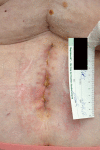Clinical presentation and diagnosis of acute postoperative spinal implant infection (PSII)
- PMID: 33447681
- PMCID: PMC7797800
- DOI: 10.21037/jss-20-587
Clinical presentation and diagnosis of acute postoperative spinal implant infection (PSII)
Abstract
Acute postoperative infections after surgical interventions on the spinal column are associated with prolonged treatment duration, poor patient outcomes, and a high socioeconomic burden. In the field of joint replacement, guidelines have been established with recommendations for the diagnosis and treatment of such complications, but in spinal surgery there are no definitions permitting distinction between early and late infections and no specific instructions for their management. Various factors increase the risk of acute postoperative infection, including blood transfusions, leakage of cerebrospinal fluid, urinary tract infection, injury of the dura mater, an American Society of Anesthesiologists (ASA) score >2, obesity, diabetes mellitus, and surgical revision. We suggest defining all infections occurring within the first 4 weeks after spinal surgery as early infections. The symptoms are pain at rest, on motion, and/or pressure pain, abnormal warmth, local erythema, circumscribed swelling of the wound, and newly occurring secretion. Together with laboratory parameters such as C-reactive protein (CRP) and leukocytes, a central role is played by imaging in the form of magnetic resonance imaging (MRI), although diagnosis can be hampered by the presence of postoperative fluid collections such as edema or hematoma or by artifacts from an implant. Once an infection has been confirmed, immediate wound revision with debridement and rinsing (sodium hypochlorite) is essential. Intraoperatively it may prove advantageous to use jet lavage and administer vancomycin. We recommend leaving the implant in place in cases of acute postoperative infection. Patients who are not conditional for surgery can first receive antibiotic suppression treatment before surgery at a later date. In such cases initial computed tomography (CT)-guided aspiration or drain insertion can take place.
Keywords: Early infection; antibiotics; implant; spine; spondylodesis.
2020 Journal of Spine Surgery. All rights reserved.
Conflict of interest statement
Conflicts of Interest: All authors have completed the ICMJE uniform disclosure form (available at http://dx.doi.org/10.21037/jss-20-587). The series “Postoperative Spinal Implant Infection (PSII)” was commissioned by the editorial office without any funding or sponsorship. TZ reports personal fees from Medtronic, outside the submitted work. PS reports personal fees from Medtronic, personal fees from SpineArt, grants from German Ministry of Economy, grants from German Spine Society, personal fees from Medacta, outside the submitted work. The other authors have no other conflicts of interest to declare.
Figures


References
-
- Calderone RR, Garland DE, Capen DA, et al. Cost of medical care for postoperative spinal infections. Orthop Clin North Am 1996;27:171-82. - PubMed
Publication types
LinkOut - more resources
Full Text Sources
Research Materials
Miscellaneous
